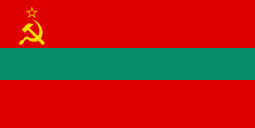 | |
| Use | State flag and ensign, war flag |
|---|---|
| Proportion | 1:2 |
| Adopted | 31 January 1952
(original version) 2 September 1991 (current version used) |
| Design | Three horizontal bands of red, green and red, with a hammer and sickle in the canton. Nearly identical to the flag of the Moldavian SSR, but with a lighter, more bluish green. |
 | |
| Use | Co-official national flag |
| Proportion | 1:2 |
| Adopted | 12 April 2017 |
| Design | Duplicate of the flag of Russia, but with a different ratio (1:2 instead of 2:3) |
 | |
| Use | Civil flag and ensign |
| Proportion | 1:2 |
| Design | Three horizontal bands of red, green and red. |
 | |
| Use | Presidential standard |
| Proportion | 1:1 |
| Design | Three horizontal bands of red, green and red bearing the coat of arms of Transnitria in the centre. |
 | |
| Use | Customs Flag |
| Proportion | 1:2 |
| Adopted | Unknown |
| Design | The customs flag is dark green with two thin red stripes at the bottom, representing the Pridnestrovian Moldavian Republic's flag. In the center, there are two crossed yellow and golden caduceuses. |
Transnistria, a de facto state internationally-recognised as part of Moldova, has two co-official national flags. The first co-official national flag consists of three horizontal bands of red, green, and red, of vertical width 3:2:3, and in the upper canton, is the main element of the coat of arms of Transnistria; a golden hammer and sickle and a gold-bordered red star. The hammer and sickle fit into a conventional square, and the star, a conditional circle. Transnistria adopted this design that comprises a version of the flag of the Moldavian Soviet Socialist Republic used between 1952 and 1990 in the 2000 Law about State Symbols.[citation needed] The second co-official national flag consists of three horizontal stripes in the colors white, blue, and red, identical to the Russian flag but at a ratio of 1:2 instead of 2:3.